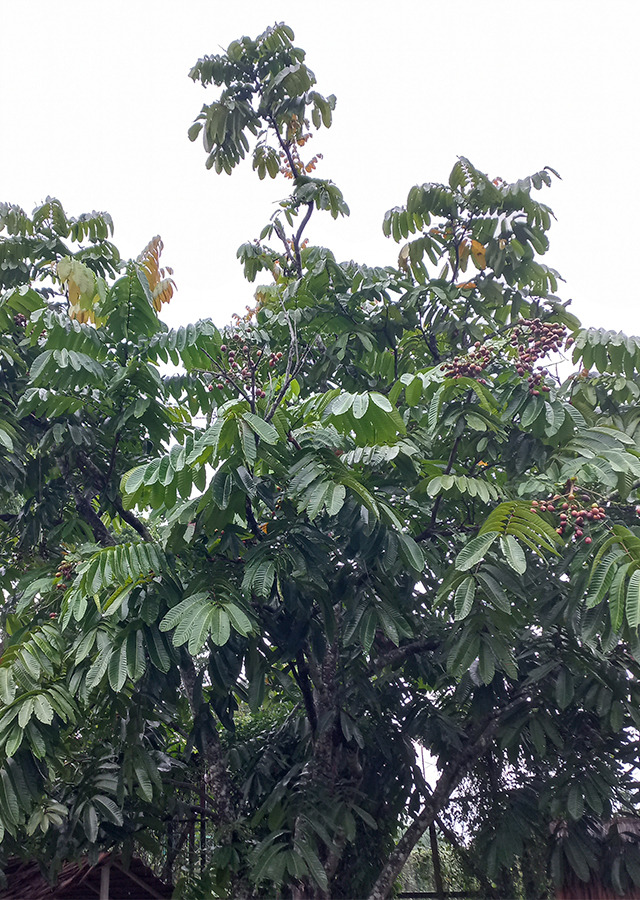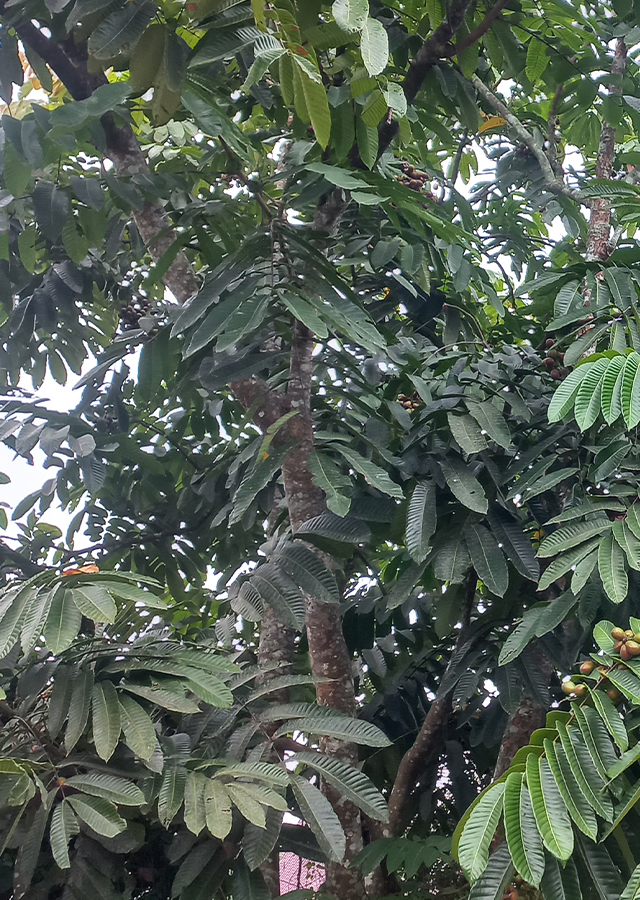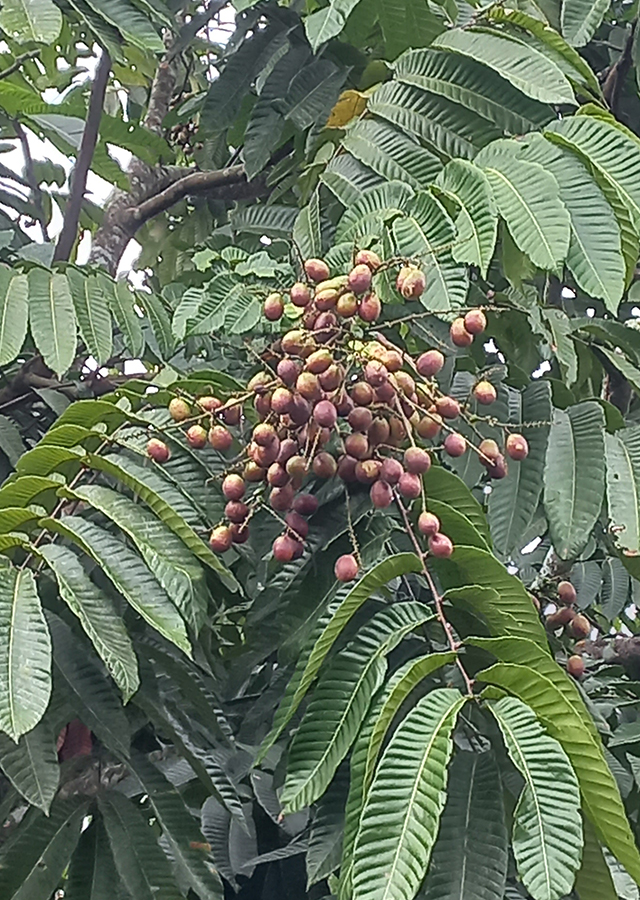Fijian Longan
Pometia pinnata J.R.Forst. & G.Forst.
Sapindaceae
Location in our garden
Principal



Synonym
Aporetica pinnata (J.R.Forst. & G.Forst.) DC.
Dabanus pinnatus (J.R.Forst. & G.Forst.) Kuntze
Euphoria pinnata (J.R.Forst. & G.Forst.) Poir.
Habitus
Trees. An evergreen perennial, large fast-growing tree that can reach of 40 m tall or more.
Part Used
Leaves
Bark
Latex
Growing Requirements
Full Sunshine
Need Shade
Habitat
Riverbanks
Forest
Terrestrial
Overview
Pometia pinnata is native to South-East Asia, China, Sri Lanka, and Pacific Islands. The plant is occasionally cultivated in its native range for its edible fruit. The oily seeds are eaten after boiling or roasting. The gum obtained from the inner bark is used to waterproof canoes. A hair shampoo is made from the bark. The timber can be used for furniture and cabinet work but must be dried to a sufficiently low moisture content. It is suitable for hardboard and particle board and as pulpwood. The wood makes a good-quality veneer which has potential to be used as decorative veneer and is very suitable for core and outer layers of plywood. The wood is a high quality fuel (as firewood and charcoal). In its native range, the plant is often used in traditional medicine to treat many diseases. Using comparisons with other foods such as lime, spirulina, and carrots, study has shown that the fruit and fruit skins contain more vitamin C which works as an antioxidant to increase the body's immune system.
Vernacular Names
Daengnam (Thai), M[aaj]t (Vietnamese), Paga-nyet-su ava (Burmese), Chieng dong (Laos), Malugai (Philippines), Kasai (Malaysia), Taun (Papua New Guinea).
Agroecology
Occurs in lowland riverbanks or humid woodlands and swampy forests. The tree is found on a variety of soils in its native range: on limestone, clayey, sandy or loamy soils, mostly in dryland forest, occasionally in freshwater swamps. Common in lowland forest, forest edges, open woodlands, lava flows, and often cultivated in villages of the Pacific Islands. It is usually found at elevations below 500 metres, though is occasionally found as high as 1,700 m. In its native range it succeeds with a mean annual rainfall in the range 1,500-5,000 mm, without a severe dry season. The mean annual temperature ranges between 22-28 °C, the mean maximum being 25-32 °C and the minimum tolerated 5-16 °C. Prefers a deep, rich, moist soil and a position in full sun or light shade.
Morphology
- Root - taproot system.
- Stem - woody, reddish brown bark; the bole which can be straight, curved or sinuous, is usually free of branches for 13-22 m and up to 100-140 cm in diameter. It is often prominently buttressed; the buttresses sharp, up to 5.5 m tall and spreading up to 3.5 m from the bole
- Leaves - alternate, stalked, compound leaves that are more than 1 m long. Each leaf consists of 4–15 pairs of leaflets, and lacks a terminal leaflet. The papery to leathery leaflets are egg-shaped to drop-shaped, slightly to distinctly sickle-shaped, red when young, dark green above and lighter green below when mature, hairless to covered with hair, 6–40 by 2–13 cm, and with toothed margins. The lowest pair of leaflets is smaller than others, round, ear-shaped or cushion-shaped, 0.4–3 by 0.3–5 cm, appearing like a stipule, and with one of the leaflets reduced.
- Flower - monoecious, producing both male and female flowers in the same individual. The flowers are about 2–2.5 mm across, generally white to green-yellow, and occur on branched flowering stalks that are 15–70 cm long.
- Fruits - fleshy fruits have a stony core each. Its fruit is ellipsoid to round, 1.5–5 by 1–3 cm, and red turning black when ripe.
- Seed - egg-shaped, unequal sided, up to 2.5 by 1.5 cm, brown, and with a white covering (aril).
Cultivation
It is generatively propagated by seed.
Chemical Constituents
Alkaloids, saponins, tannins, flavonoids, phenolic compounds, terpenoids.
Traditional Medicinal Uses
- It is used to treat deep pains in the bones, migraine headache, to aid expulsion of placenta after childbirth, to relieve rheumatic aching of muscles and joints, to relieve fever, as a remedy for flu and cold, to cure diarrhoea, stomach trouble, cough, fever, constipation, and diaper rash.
- The leaves are antimicrobial. A decoction of the leaves or bark is used medicinally against fever and sores. An infusion of the leaves is rubbed onto the heads of infants or is given internally to treat unclosed fontanelles.
- An infusion of the bark is used as an emetic for mouth infections, colds and mucous congestion, and to treat abdominal pains. A decoction of the bark is used to treat mouth cancers.
- Bark used by Malays and Indonesians to treat sores and wound infections.
Part Used
Reference Sources
- CAB International. (2019). Pometia pinnata (fijian longan). https://www.cabi.org/isc/datasheet/42815. 29-09-2022.
- Fern, Ken. (2022). Useful Tropical Plants: Pometia pinnata. https://tropical.theferns.info/viewtropical.php?id=Pometia+pinnata. 29-09-2022.
- Kew Royal Botanic Gardens. (No date). Plants of the World Online: Pometia pinnata J.R.Forst. & G.Forst.. https://powo.science.kew.org/taxon/urn:lsid:ipni.org:names:784485-1#synonyms. 29-09-2022.
- National Park of Singapore. (2021). Flora Fauna Web: Pometia pinnata J. R. Forst. & G. Forst.. https://www.nparks.gov.sg/florafaunaweb/flora/3/0/3084. 29-09-2022.
- Rahmah, Widya, et al. (2021). POTENTIAL OF MATOA FRUIT EXTRACT (POMETIA PINNATA) AS ANTIOXIDANT SOURCE. Jurnal Farmasi Sains dan Praktis, Vol.7(1). Also available: https://journal.unimma.ac.id/index.php/pharmacy/article/view/4240.

